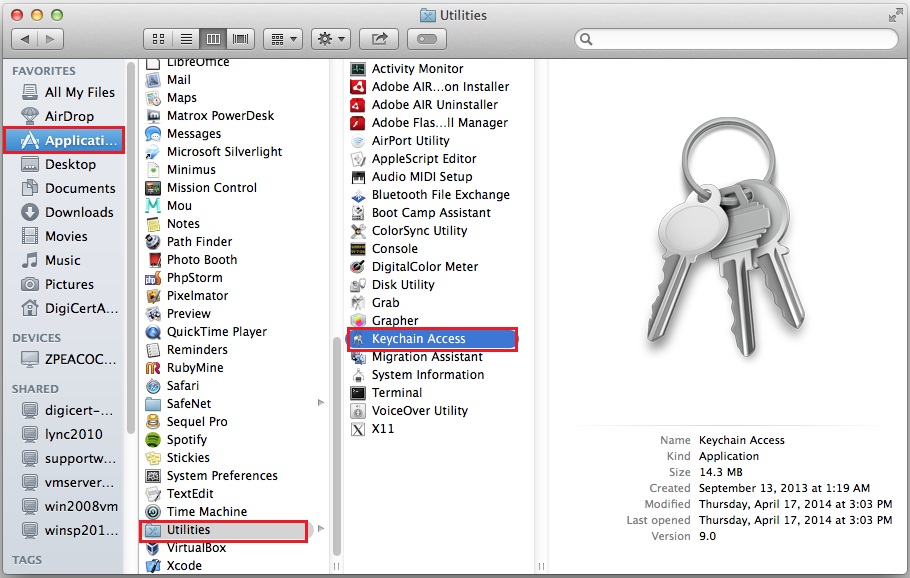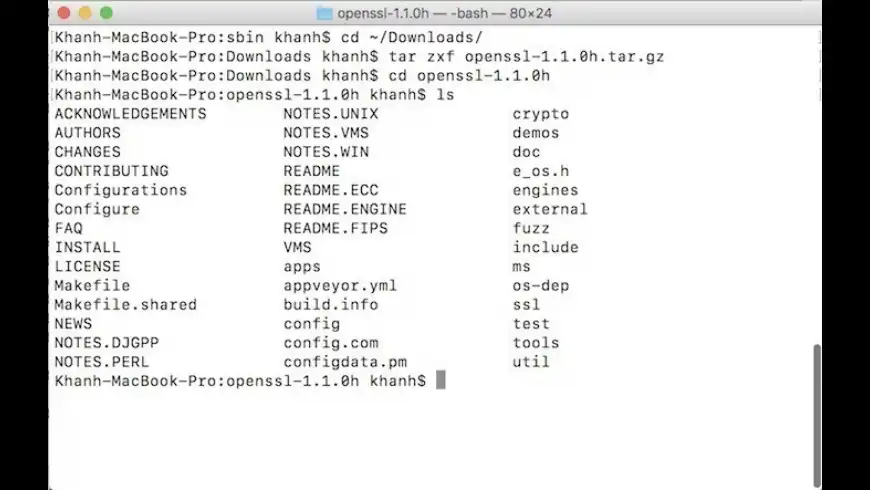The OpenSSL-Universal Framework is a Fat Binary. That means it supports multiple CPU architectures in a single file. To understand this, return to Terminal. Navigate to your OpenSSL-Universal macOS files and run the command file libcrypto.a This will tell you architecture the file is compiled against x8664. Download the PCRE library. The PCRE library distribution (version 4.4 — 8.41) needs to be downloaded from the PCRE site and extracted. The rest is done by nginx’s./configure and make. PCRE is required for the httprewritemodule, and also for regular expressions support in the location directive. Configure Nginx. Openssl for mac free download. OpenSSL for Windows OpenSSL is a robust, commercial-grade, and full-featured toolkit for the Transport Layer Security (T. OpenSSL Software Foundation / OpenSSL (64-bit) Old Versions: Filename: Win64OpenSSL-102u.exe. Popular Alternatives to OpenSSL for Windows, Linux, Mac, Android, iPhone and more. Explore 9 apps like OpenSSL, all suggested and ranked by the AlternativeTo user community. By using a general flag –help we can see an overview of all valid options for openssl version. Openssl version –help. There are eight (8) valid options that allow you to narrow your search. The option that provides the most comprehensive set of information is: openssl version –a. This command compiles all the information.
OpenSSL provides support for the TLS and SSL protocols and also includes various tools used in cryptography. Note that OpenSSL is officially available only as source, so you must manually compile and install the software on your Mac.
Deploy the OpenSSL toolkit via the command line
To install the OpenSSL toolkit and library on your Mac, you must open the Terminal application, go to the OpenSSL source folder, and follow the instructions from the INSTALL file included in the archive.
For short, you must run the './config', 'make', 'make test', and 'make install' commands, and then type openssl in the Terminal. If you need to see what OpenSSL release you are using, you can use the 'version' argument.
Note that you must make sure you are using the correct PATH to reach the latest OpenSSL installation. When you install OpenSSL, you get to see the output location, and you can check the path used by default with the 'which openssl' shell command.
Older OpenSSL versions are delivered with the system by default, and the old link will most likely be preserved. This means that you must configure the shell to use the correct path on your own.
Worth mentioning is that you can also install the toolkit using a package management solution such as Homebrew.
Quick access to SSL and Crypto libraries
While in OpenSSL's command line interface, you get to see all the standard, message digest, or cipher commands supported by OpenSSL, but you do not get usage instructions.

Make sure to check the online documentation to read extensive descriptions and learn about configuration options for each of the included commands.
OpenSSL's developers also provide a Frequently Asked Questions section where you can get details about the latest version, about how you can use the commands, and so on.
To conclude, the OpenSSL software package offers you the possibility to work with the SSL and TLS protocols or to access cryptography tools, as long as you are willing to work with the command line.
-->
PowerShell 7.0 or higher require macOS 10.13 and higher. All packages are available on our GitHubreleases page. After the package is installed, run pwsh from a terminal.
Note
PowerShell 7.2 is an in-place upgrade that removes previous versions of PowerShell 6.x and 7.x.
The /usr/local/microsoft/powershell/6 folder is replaced by /usr/local/microsoft/powershell/7.
If you need to run an older version of PowerShell side-by-side with PowerShell 7.2, installthe version you want using the binary archive method.
Supported versions of macOS
The following table is a list of currently supported PowerShell releases and the versions ofWindows they are supported on. These versions remain supported until either the version ofPowerShell reaches end-of-support or the version of[macOS reaches end-of-support][eol-windows].
- A ✅ indicates that the version of the OS or PowerShell is still supported
- A ❌ indicates that the version of the OS or PowerShell isn't supported
- A 🟡 indicates the version of PowerShell is no longer supported on that version of the OS
- When both the version of the OS and the version of PowerShell have ✅, that combination issupported
| macOS | 7.0 (LTS) | 7.1 (current) | 7.2 (LTS-preview) |
|---|---|---|---|
| ✅ macOS Big Sur 11.5 | ✅ | ✅ | ✅ |
| ✅ macOS Catalina 10.15 | ✅ | ✅ | ✅ |
| ✅ macOS Mojave 10.14 | ✅ | ✅ | ✅ |
| ✅ macOS High Sierra 10.13 | ✅ | ✅ | ❌ |
Support of macOS is defined by Apple. For more information, see:
PowerShell is supported on macOS for the following processor architectures:
| macOS | 7.0 (LTS) | 7.1 (current) | 7.2 (LTS-preview) |
|---|---|---|---|
| macOS Big Sur 11.5 | x64 | x64 | x64, Arm64 |
| macOS High Sierra 10.13+ | x64 | x64 | x64 |
Installation of latest stable release via Homebrew on macOS 10.13 or higher
There are several ways to install PowerShell on macOS. Choose one of the following methods:
- Install using Homebrew. Homebrew is the preferred package manager for macOS.
- Install PowerShell via Direct Download
- Install from binary archives.
After installing PowerShell, you should install OpenSSL. OpenSSL isneeded for PowerShell WSMan remoting.
Mac Update Openssl
If the brew command is not found, you need to install Homebrew followingtheir instructions.
Now, you can install PowerShell:
Finally, verify that your install is working properly:
When new versions of PowerShell are released, update Homebrew's formulae and upgrade PowerShell:
Note
The commands above can be called from within a PowerShell (pwsh) host,but then the PowerShell shell must be exited and restarted to complete the upgradeand refresh the values shown in $PSVersionTable.
Installation of latest preview release via Homebrew on macOS 10.13 or higher
After you've installed Homebrew, you can install PowerShell. First, install the Cask-Versionspackage that lets you install alternative versions of cask packages:
Now, you can install PowerShell:
Finally, verify that your install is working properly:
When new versions of PowerShell are released, update Homebrew's formulae and upgrade PowerShell:
Note
The commands above can be called from within a PowerShell (pwsh) host,but then the PowerShell shell must be exited and restarted to complete the upgrade.and refresh the values shown in $PSVersionTable.
Installing PowerShell using the Homebrew tap method is also supported for stable and LTS versions.
You can now verify your install
When new versions of PowerShell are released, simply run the following command.
Note
Whether you use the cask or the tap method, when updating to a newer version of PowerShell, usethe same method you used to initially install PowerShell. If you use a different method, opening anew pwsh session will continue to use the older version of PowerShell.

If you do decide to use different methods, there are ways to correct the issue using theHomebrew link method.
Installation via Direct Download
PowerShell 7.2 addes support for the Apple M1 processor. Download the install package from thereleases page onto your computer. The links to the current versions are:
- PowerShell 7.2-preview.10
- x64 processors -
https://github.com/PowerShell/PowerShell/releases/download/v7.2.0-preview.10/powershell-7.2.0-preview.10-osx-x64.pkg - M1 processors -
https://github.com/PowerShell/PowerShell/releases/download/v7.2.0-preview.10/powershell-7.2.0-preview.10-osx-arm64.pkg
- x64 processors -
- PowerShell 7.1.4 -
https://github.com/PowerShell/PowerShell/releases/download/v7.1.4/powershell-7.1.4-osx-x64.pkg - PowerShell 7.0.7 -
https://github.com/PowerShell/PowerShell/releases/download/v7.0.7/powershell-7.0.7-osx-x64.pkg
You can double-click the file and follow the prompts, or install it from the terminal using thefollowing commands. Change the name of the file to match the file you downloaded.
Install OpenSSL. OpenSSL is needed for PowerShell remoting and CIMoperations.
Install as a .NET Global tool
If you already have the .NET Core SDK installed, it's easy to install PowerShellas a .NET Global tool.
The dotnet tool installer adds ~/.dotnet/tools to your PATH environment variable. However, thecurrently running shell does not have the updated PATH. You should be able to start PowerShellfrom a new shell by typing pwsh.
Install OpenSSL. OpenSSL is needed for PowerShell remoting and CIMoperations.
Binary Archives
PowerShell binary tar.gz archives are provided for the macOS platform to enable advanceddeployment scenarios. When you install using this method you must also manually install anydependencies.
Install OpenSSL. OpenSSL is needed for PowerShell remoting and CIMoperations.
Note
Openssl Mac Os
You can use this method to install any version of PowerShell including the latest:
- Stable release: https://aka.ms/powershell-release?tag=stable
- Preview release: https://aka.ms/powershell-release?tag=preview
- LTS release: https://aka.ms/powershell-release?tag=lts
Installing binary archives on macOS
Download the install package from the releases page onto your computer. The links to thecurrent versions are:
- PowerShell 7.2-preview.10
- x64 processors -
https://github.com/PowerShell/PowerShell/releases/download/v7.2.0-preview.10/powershell-7.2.0-preview.10-osx-x64.tar.gz - M1 processors -
https://github.com/PowerShell/PowerShell/releases/download/v7.2.0-preview.10/powershell-7.2.0-preview.10-osx-arm64.tar.gz
- x64 processors -
- PowerShell 7.1.4 -
https://github.com/PowerShell/PowerShell/releases/download/v7.1.4/powershell-7.1.4-osx-x64.tar.gz - PowerShell 7.0.7 -
https://github.com/PowerShell/PowerShell/releases/download/v7.0.7/powershell-7.0.7-osx-x64.tar.gz
Use the following commands to install PowerShell from the binary archive. Change the download URL tomatch the version you want to install.

Installing dependencies
OpenSSL is required for PowerShell remoting and CIM operations. You can install OpenSSL via MacPortsif needed.
Note
MacPorts and Homebrew can have problems when used to together on the same system. However,Homebrew does not have a package for OpenSSL 1.0. For more information, see theMacPorts FAQ.
Install the Xcode command-line tools. The Xcode tools are required by MacPorts.
Install MacPorts. If you need instructions, refer to theinstallation guide.
Update MacPorts by running
sudo port selfupdate.Upgrade MacPorts packages by running
sudo port upgrade outdated.Install OpenSSL by running
sudo port install openssl10.Link the libraries to make them available to PowerShell:
Uninstalling PowerShell
If you installed PowerShell with Homebrew, use the following command to uninstall:
If you installed PowerShell via direct download, PowerShell must be removed manually:
To remove the additional PowerShell paths, refer to the paths section in this documentand remove the paths using sudo rm.
Note
This is not necessary if you installed with Homebrew.
Paths
$PSHOMEis/usr/local/microsoft/powershell/7.1.4/- User profiles will be read from
~/.config/powershell/profile.ps1 - Default profiles will be read from
$PSHOME/profile.ps1 - User modules will be read from
~/.local/share/powershell/Modules - Shared modules will be read from
/usr/local/share/powershell/Modules - Default modules will be read from
$PSHOME/Modules - PSReadline history will be recorded to
~/.local/share/powershell/PSReadLine/ConsoleHost_history.txt
The profiles respect PowerShell's per-host configuration. So the default host-specific profileexists at Microsoft.PowerShell_profile.ps1 in the same locations.
PowerShell respects the XDG Base Directory Specification on macOS.
Because macOS is a derivation of BSD, the prefix /usr/local is used instead of /opt. So,$PSHOME is /usr/local/microsoft/powershell/7.1.4/, and the symbolic link is placed at/usr/local/bin/pwsh.
Installation support
Microsoft supports the installation methods in this document. There may be other methods ofinstallation available from other sources. While those tools and methods may work, Microsoft cannotsupport those methods.



